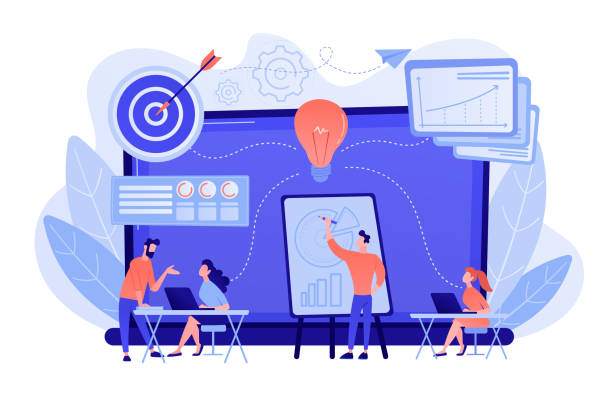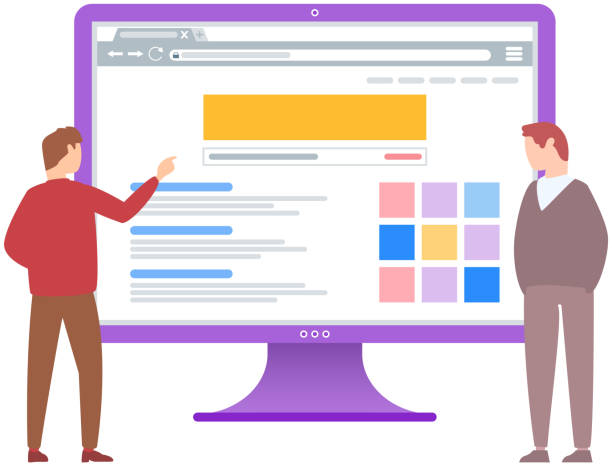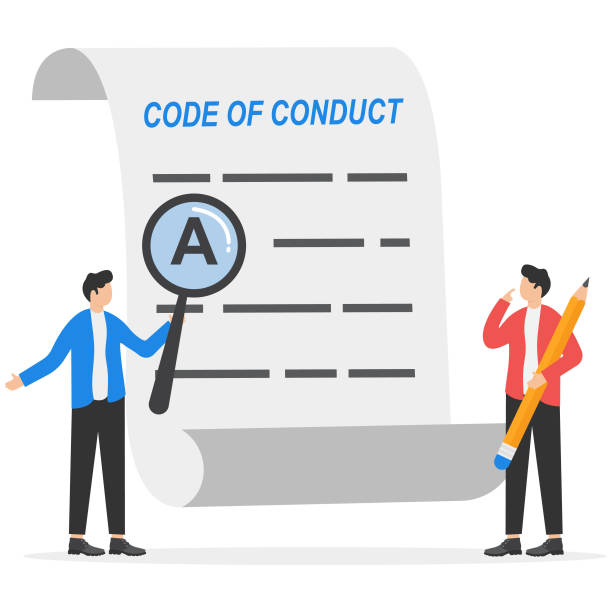Introduction to the Importance of Multilingual Website Design

In the era of globalization and the unprecedented expansion of information technology, reaching international audiences is no longer a luxury but a necessity for the growth and survival of any business.
#Today, multilingual website design is recognized as a vital step for entering global markets and effective communication with users from different nationalities and cultures.
This approach not only allows your products or services to be offered to a wider range of customers but also significantly enhances your brand’s international credibility and image.
A website limited to a single language is, in fact, losing countless opportunities to attract visitors and convert them into loyal customers.
On the other hand, investing in building multilingual websites not only yields high financial returns but also opens new avenues for cultural and commercial exchanges.
This is especially important for companies planning to export or offer their services online worldwide.
To better understand this necessity, imagine a potential user from another country looking for a product or service you offer, but your website is only available in Persian.
This user will likely leave your page without hesitation and go to competitors who offer their content in their native language.
This is where the role of multicultural website design becomes prominent.
It is a strategic decision that helps businesses remove language barriers and send a consistent and understandable message to all their audiences, regardless of their language and geographical location.
This not only increases conversion rates but also significantly helps improve the website’s ranking in international search engines.
In this article, we will delve into how to achieve this goal and the solutions ahead.
Next, we will explore various aspects of multilingual website development, from advantages to challenges and technical and content solutions, so you can make an informed decision for the digital future of your business.
Our goal is to provide you with a comprehensive and explanatory guide to confidently step onto the path of globalization.
Is your e-commerce site ready to attract maximum customers and increase sales? Rasaweb transforms your online business with modern and efficient e-commerce website design.
✅ Increased speed and improved SEO
✅ Excellent user experience on mobile and desktop⚡ Get free e-commerce website design consultation from Rasaweb!
Competitive Advantages of Multilingual Websites

In today’s competitive market, every small advantage can make a big difference, and a #multilingual_website brings exactly that advantage to your business.
One of the most important competitive advantages is market penetration expansion.
By offering your content in multiple languages, you open new doors to international markets that were previously inaccessible to you.
This means gaining access to millions of new users who do not speak Persian and prefer to receive information in their native language.
This increased access to potential customers directly leads to increased sales and revenue.
Furthermore, multilingual website design significantly helps improve your International SEO.
Search engines like Google prioritize websites that offer relevant and localized content in different languages in their search results for users of those languages.
This means that with the correct implementation of hreflang structure and keyword translation, your website will appear in search results in various countries and attract more organic traffic.
This not only brings more visitors to your site but also provides more targeted traffic, which is more likely to convert into customers.
Another advantage is increased brand trust and credibility.
When a user sees that your website is available in their language, they feel more comfortable and connected to your brand.
This shows that you care about the needs of your global audience and strive to provide the best user experience.
This level of customer attention builds long-term loyalty and trust, ultimately leading to increased repeat purchases and new customer referrals.
A multilingual website, in a way, provides you with #analytical_content of the global market and helps you analyze user behavior from different cultures and adjust your marketing strategies accordingly.
This precise market analysis capability allows you to make more informed business decisions and enhance your international competitiveness.
Challenges and Solutions for Implementing Multilingual Website Design

Although multilingual website design offers numerous advantages, it also comes with challenges that need to be understood and planned for.
One of the main challenges is quality content management and translation.
Simply translating words is not enough; content must be localized, meaning adapted to the cultural nuances, local idioms, and even the sense of humor of each region.
This requires the expertise of native translators familiar with SEO principles.
#Another_challenge relates to the website’s technical structure.
Choosing the correct method for presenting different languages (subdomains, subdirectories, or top-level domains) directly impacts SEO and user experience.
The solutions to these challenges are diverse.
For content management, using powerful Content Management Systems (CMS) like WordPress with multilingual plugins such as WPML or Polylang, or custom systems designed from the outset for multilingual support, can be very effective.
These systems enable easy organization and translation of content.
In the technical realm, correctly implementing hreflang tags in the HTML code of each page to indicate its language and regional version to search engines is crucial.
These tags help search engines display the correct version of a page to users in different regions and prevent duplicate content issues.
Another challenge is the continuous maintenance and updating of translated content.
When new content is added to the original language, there must also be a regular process for translating and localizing it into other languages to ensure the site is always up-to-date and complete.
This section requires #guidance and specialized_content.
Using Translation Management Systems (TMS) can automate and streamline this process.
Also, paying attention to bandwidth and site loading speed in different parts of the world, especially if they are far from the main servers, is important.
Using a CDN (Content Delivery Network) can solve this problem.
These technical aspects, though seemingly complex, are essential for ensuring correct functionality and optimal user experience in multilingual website projects.
Ultimately, precise planning and leveraging the expertise of experienced teams in creating international portals can turn all these challenges into opportunities and pave the way for global success.
Table 1: Comparison of Multilingual Implementation Methods
| Method | Advantages | Disadvantages | SEO Impact |
|---|---|---|---|
| Subdirectories | Easier management, main domain’s SEO strength | Requires precise URL structure, may be less clear to users | Very good, transfers authority to the main page |
| Subdomains | Separate hosting for each language, high flexibility | More complex SEO management, requires separate domain authority | Good, but each subdomain is treated as a separate site |
| Top-Level Domain (TLD) | Clear geographic identification, best for local SEO | High cost, requires managing multiple domains | Excellent for local SEO, but each domain’s authority is separate |
| URL Parameters | Simplest implementation, no new domain/subdomain needed | Weakest for SEO, may be ignored by Google | Very poor, not recommended |
Choosing the Right Platform and Tools for Multilingual Website Design

Choosing the right #platform and tools is the cornerstone of success in multilingual website design.
This decision should be made considering the specific business needs, budget, and the team’s technical knowledge.
Content Management Systems (CMS) like WordPress, Joomla, Drupal, and Shopify are popular options that provide multilingual support through their plugins and built-in functionalities.
WordPress, as the most widely used CMS in the world, with plugins such as WPML (WordPress Multilingual Plugin) and Polylang, offers powerful features for translating content, categories, tags, and even site templates.
These plugins enable easy management of languages and localized content.
For larger and more complex websites that require more control over architecture and performance, using web development frameworks like Laravel, React, or Angular along with dedicated Translation Management Systems (TMS) can be a better option.
This approach requires higher technical expertise but provides unparalleled flexibility in customization and performance optimization.
It is important that the chosen platform offers #training capabilities for your team and can be easily scalable so that in the future, with business growth, there is no need for fundamental changes in the site’s infrastructure.
In addition to the main platform, other tools are also vital for the success of a multilingual website project.
Automatic translation tools like Google Translate API can be useful in the initial stages for creating quick drafts, but they can never replace human translation and qualitative localization.
International SEO tools like Google Search Console and Ahrefs are crucial for monitoring site performance in various search engines and identifying improvement opportunities.
Also, web analytics tools like Google Analytics are essential for tracking user behavior from different regions and languages so you can optimize the user experience.
The correct selection of these tools is key to successfully implementing an efficient and effective multilingual website that not only meets your current needs but is also ready for future growth and development.
With a smart choice, you can smooth the process of building multilingual websites and achieve desired results.
Does your current e-commerce website design lead to losing potential customers and sales?
Rasaweb, with its professional and user-friendly e-commerce website design, is your solution!
✅ Significant increase in conversion rates and sales
✅ Full optimization for search engines and mobile
⚡ [Get free e-commerce website design consultation from Rasaweb]
SEO Optimization for Multilingual Websites

SEO optimization for a multilingual website goes beyond merely translating keywords.
This process involves a set of #specialized techniques that help search engines display the correct content to the right audience, at the right time, and in the appropriate language.
The first step is the correct use of hreflang tags.
These tags are placed in the <head> section of the HTML page and inform search engines that different language versions of a page are related to each other.
This prevents the problem of duplicate content and ensures that users are directed to the appropriate language version.
#Educational_content about international SEO shows that URL structure is also very important.
As mentioned in previous sections, using subdirectories (e.g., yoursite.com/en/ and yoursite.com/fa/) or top-level domains (e.g., yoursite.co.uk and yoursite.de) typically perform best for SEO.
Each of these structures has its advantages and disadvantages, but both help search engines clearly identify content in different languages.
Also, for each language and region, keywords must be carefully researched and translated.
This means finding keywords that are not just literal translations of the original words, but rather words and phrases that native users actually use to search for similar products or services.
Local keyword research tools can help in this regard.
Furthermore, building internal and external links for each language version of the site is also important.
Try to acquire quality links from local and relevant websites in each region.
This helps increase domain authority in that geographic area.
The site’s content should also be fully localized and not just machine-translated.
This means paying attention to cultural differences, local idioms, and even currency and measurement systems.
This approach to multilingual website design helps you not only achieve a better ranking in international search results but also provide a better user experience for your global audience, ultimately leading to increased traffic, conversion rates, and business success.
By following these principles, you can ensure that your multicultural website development proceeds in the best possible way.
Cultural Differences and the Importance of Content Localization in Multilingual Website Design

One of the most important aspects often overlooked in multilingual website design is the importance of going beyond mere translation and the necessity of complete content localization.
#Localization means adapting content to the cultural, social, and even political characteristics of a specific region.
This process is much deeper than replacing words from one language to another and involves understanding cultural nuances, local idioms, sense of humor, color preferences, symbols, and even the way numbers and dates are used.
For example, the color red symbolizes love and passion in some cultures, while in others it can symbolize danger or anger.
Ignoring these differences can lead to misunderstandings, unintentional offense, and ultimately the loss of audience trust.
Content localization helps your website connect with your target audience on a deeper level.
This makes users feel that the content is designed for them and their culture, rather than being merely a dry and lifeless translation.
This approach not only improves the user experience but also enhances your brand’s credibility and shows that you value your audience.
On the other hand, #questionable_content in this area can help you identify your weaknesses.
Is your logo acceptable across different cultures? Do the images used on the site convey the correct message?
Localization includes various aspects: translation and rewriting of texts by native translators, adapting images and videos to local culture, adjusting date and time formats, currency and measurement systems, and even adapting content related to local events and holidays.
Also, it should be noted that some words or phrases may have a positive meaning in one culture, while being completely irrelevant or even offensive in another.
Therefore, for creating international portals, collaboration with localization experts and professional translators who are proficient not only in the language but also in the culture and target market is essential.
This fundamental step will guarantee the success of your website in attracting and retaining global audiences and effectively assist you in building multilingual websites.
Content Management and Updates on Multilingual Websites

Managing content and regular updates on a multilingual website can be more complex than for a single-language site.
#Continuous_maintenance of translated content and ensuring its synchronization with the original version, is one of the main challenges.
Whenever new content is added to the original language or existing content is updated, these changes must also be applied and translated in all other language versions.
Failure to do so can lead to content inconsistencies, user confusion, and even SEO problems.
To overcome this challenge, it is essential to use a well-defined strategy and appropriate tools.
One effective solution is to implement a clear translation and localization workflow.
This workflow should include steps for identifying new or updated content, sending it for translation, review by native translators, and then publishing it on the site.
Using Translation Management Systems (TMS) or powerful CMS plugins that have the capability to synchronize and manage translations can significantly simplify this process.
These tools allow for centralized management of translations, tracking their status, and even using Translation Memory to speed up the process and maintain terminology consistency.
Furthermore, regularly reviewing user feedback from different regions and languages is very important.
This feedback can help you identify parts of the content that require further review or more precise localization.
Also, monitoring SEO performance for each language version separately ensures that each language performs well independently in local search engines.
For multilingual website development, it is recommended to create a content calendar for each language to ensure that new content is planned and published regularly.
This helps keep the site fresh and appealing to global audiences.
Overall, proper content management in multilingual website design is a complex process that requires precise planning and the use of appropriate tools to ensure the website is always up-to-date, accurate, and efficient for all global audiences.
This section includes #specialized_content for maintaining content quality.
Table 2: Key Tasks in Multilingual Content Management
| Task | Description | Suggested Tools |
|---|---|---|
| Content Synchronization | Ensuring translated content matches the original version | Multilingual CMS plugins (WPML), TMS |
| Translation Management | Tracking translation status, translators, and budget | TMS (e.g., Smartling, Phrase), Project management systems |
| Native Review | Checking and confirming the quality of translation and localization by native speakers | Online collaboration platforms, review meetings |
| Local SEO Optimization | Native keyword research, hreflang tag configuration | Google Search Console, Ahrefs, Semrush |
| Performance Analysis | Monitoring traffic, bounce rate, and conversion for each language version | Google Analytics, Hotjar |
User Experience and User Interface in Multilingual Website Design

User Experience (UX) and User Interface (UI) play a vital role in the success of a #multilingual_website.
Designing an effective UI/UX for a global website goes beyond translating buttons and menus; it means deeply understanding the expectations and behaviors of users from different cultures.
Multilingual website design should allow users to easily select their desired language.
The language switcher should be placed in an accessible and clear location (usually in the header or footer) and displayed as a dropdown menu with full language names (not just country flags, as a single language may be spoken in multiple countries and a flag might be misleading).
Another important aspect is layout and visual design.
Languages differ in word length and reading direction (right-to-left or left-to-right).
For example, text translated into German might be much longer than its English version, which can disrupt the page layout.
Designers must consider the necessary flexibility in design to accommodate these changes.
Also, fonts must be able to correctly display characters of all supported languages.
Images and icons should also be chosen in a way that conveys the same meaning across all cultures and does not create misunderstandings.
This part of the #educational_content is very important.
#Guidance for improving user experience includes ensuring appropriate site loading speed in all regions of the world.
International users expect high speed, and delays can lead to site abandonment.
Using a CDN (Content Delivery Network) to store content on servers close to users, can solve this problem.
Also, contact forms, dates, and currency should be localized to be understandable and functional for users in each region.
Paying attention to all these details in multicultural website development, not only increases user satisfaction but also significantly helps improve conversion rates and reduce bounce rates.
An excellent user experience encourages users to stay on your site longer and become loyal customers.
Does your current e-commerce website design lead to losing customers and sales?
Rasaweb, with its modern and user-friendly e-commerce website design, is your solution!
✅ Significant increase in conversion rates and sales
✅ Strong branding and building customer trust
⚡ Get free e-commerce website design consultation from Rasaweb!
The Future of Multilingual Website Design and Emerging Trends

The future of #multilingual_website_design is rapidly evolving, with several emerging trends shaping how businesses interact with global audiences.
One of the most important trends is the significant advancements in Artificial Intelligence (AI) and Machine Learning (ML).
These technologies are currently improving the quality of machine translation and, in the future, can elevate localization capabilities to new levels.
AI-powered translation systems will be able to not only translate text but also adapt tone, emotion, and even writing style to the target culture.
This will significantly increase the speed and efficiency of the multilingual website building process.
Another trend is the increasing importance of voice search.
With the widespread use of voice assistants like Siri, Google Assistant, and Alexa, optimizing websites for multilingual voice search will become increasingly vital.
This means focusing on conversational keywords and direct answers to questions.
#News_content in the field of technology also indicates that Virtual Reality (VR) and Augmented Reality (AR) could play a significant role in multicultural website development in the future, especially in areas like e-commerce and tourism, where interactive and immersive experiences can be provided in different languages.
We are also seeing an increased demand for #No-Code and Low-Code multilingual website design platforms that enable small and medium-sized businesses to build and manage their multilingual websites without needing deep programming knowledge.
These tools democratize access to the global market for a wider range of businesses.
Finally, with the growth of the Internet of Things (IoT) and the need to present information in various languages on connected devices, creating international portals capable of supporting all devices and platforms, will become a standard.
These trends indicate that the future of this field is moving increasingly towards automation, intelligence, and greater accessibility for everyone, and businesses that prepare for these changes now will have a significant competitive advantage.
Conclusion and Next Steps Towards Successful Multilingual Website Design

As thoroughly discussed in this article, multilingual website design is no longer just an option but a strategic necessity for any business aiming for successful global market presence.
From expanding market reach and improving international SEO to increasing customer trust and providing an exceptional user experience, the benefits of this approach are undeniable.
However, achieving a successful multilingual website requires precise planning, selecting appropriate tools, and paying attention to cultural and technical details.
Your #next_step should include a comprehensive assessment of your business needs, target market, and available resources.
To begin, it is recommended to start with a #detailed_analysis of your target audience in different countries.
This analysis should include understanding their linguistic and cultural needs, and search behaviors.
Then, develop a comprehensive strategy for content translation and localization that not only guarantees translation quality but also simplifies content update processes.
Choosing the right platform and supporting tools is also of high importance to best advance your multilingual website project.
Finally, correctly implementing international SEO techniques, such as using hreflang tags and appropriate URL structure for each language, is key to attracting organic traffic from around the world.
Also, don’t forget that user experience and user interface, are the core of a successful multilingual website; therefore, the design must be flexible and adaptable to all languages and cultures.
Given emerging trends in AI and voice search, preparing the website for the future is also very important.
By following these steps and making appropriate investments in this area, you can ensure that your website not only transcends geographical boundaries but also becomes a powerful tool for your business’s global growth and success.
This is a comprehensive_guide to achieving your global goals.
Frequently Asked Questions
| Question | Answer |
|---|---|
| What is multilingual website design? | It is the design of a website whose content is available to users in several different languages, so that users can choose their preferred language. |
| Why is a multilingual website important? | To reach international audiences, increase website traffic, improve user experience for non-Persian speaking visitors, and expand business into global markets. |
| What are the benefits of having a multilingual website? | Increased international SEO, attracting new customers from different countries, enhancing business credibility and professionalism, and reducing bounce rate by providing understandable content. |
| What are the methods for implementing a multilingual website? | Using subdirectories (e.g., example.com/en/), subdomains (e.g., en.example.com), or separate top-level domains for each language (e.g., example.com and example.de). |
| Which URL structure is best for international SEO? | Subdirectories (e.g., example.com/en/) are often preferred for SEO due to consolidating the main domain’s authority, although each method has its advantages and disadvantages. |
| How does a multilingual website affect SEO? | By providing content in different languages, the site appears in local search results for those languages, increasing click-through rates and traffic, and improving the overall domain authority of the site. Correct use of hreflang tags is very important. |
| How is content translation managed? | Professional translators, machine translation tools (with human editing), or Content Management Systems (CMS) with built-in multilingual capabilities or relevant plugins can be used. |
| What are the common challenges in multilingual website design? | Managing translated content, maintaining design consistency across different languages, compatibility with Right-to-Left (RTL) languages like Persian and Arabic, optimizing SEO for each language, and choosing the appropriate URL structure. |
| How do I manage text direction (LTR/RTL) on a multilingual site? | For Right-to-Left languages (like Persian), you need to apply specific CSS styles to change text direction, element layout, and table direction. Often by using the direction: rtl; property and other related settings. |
| How can users change the site language? | Usually by using a button, dropdown menu, or language selector widget clearly placed in the site’s header or footer. Automatic detection of the user’s browser language and suggesting a language change is also common. |
And other services of RasaWeb Advertising Agency in the field of advertising
Smart Google Ads: A combination of creativity and technology to improve SEO ranking through exclusive programming.
Smart Advertising Campaign: An exclusive service for growth and SEO ranking improvement based on precise audience targeting.
Smart Data Analysis: Designed for businesses looking to improve SEO ranking through marketing automation.
Smart Google Ads: An effective tool for attracting customers through Google advertising management.
Smart Direct Marketing: Designed for businesses seeking digital branding through user experience customization.
And over a hundred other services in the field of internet advertising, advertising consultation, and organizational solutions.
Internet Advertising | Advertising Strategy | Advertorial
Resources
Google’s Internationalization Guide
MDN Documentation on Content-Language
Getting Started with WPML (WordPress Multilingual)
W3C Articles on Language Tags
✅? Are you looking for a big leap in the digital world? “Rasaweb Afarin” Digital Marketing Agency, with expertise in Search Engine Optimization (SEO), professional social media management, and user-friendly website design, guides your business towards success. With us, have a powerful and lasting presence in the online space.
📍 Tehran, Mirdamad Street, next to Bank Markazi, Southern Kazeroon Alley, Ramin Alley, No. 6


